Leeds United have been one of the most intriguing sides to have been promoted to the Premier League in recent seasons, and have certainly garnered a lot more attention from the media than one would expect of a promoted side. This is partly due to Leeds’ status as one of English football’s great old clubs, and their long-awaited rise back to the top table after decades spent in the Championship and even lower. The majority of the attention, however, has been brought by the presence of Marcelo Bielsa on the touchline. The legendary Argentinian manager has amassed a cult following among the Leeds faithful, and he certainly has his fans in English football as well, even if there are many who believe that he is ‘naive’ for looking to play a high-energy, attacking style of football no matter the opponent. Leeds have had a decent outing in the Premier League so far – currently in 11th place with 29 points, having been part of some stunning games this season, and look like they will survive comfortably, thereby achieving their aim for their first season back. Their recruitment in the summer window has been a big reason for this, with Leeds bringing in some proven quality as well as young players who can be moulded and developed by Bielsa, and the biggest impact of all those arrivals has undoubtedly been made by Raphinha.
The Brazilian winger, who arrived from French club Rennes for £17 million, took a little while to settle at Elland Road, but he has become one of the most dangerous attackers in the league over the last few weeks. He has also become an integral part of Bielsa’s system, with the manager’s faith best being shown by the fact that Raphinha has rarely been rested over the last month or so – the biggest sign that Bielsa trusts you, since he rarely changes his first-choice XI too much. The 24-year-old may only still be in his first season in English football, but he has already had a considerable impact, and this scout report will look into how Leeds’ tactics have been helped by having him in the XI, as well as the influence he has had on Bielsa’s lineup.
Playing and statistical profile
Raphinha is a 24-year-old winger, standing at around 5’9″ and weighing 58 kgs. Thus, he is a relatively light player, with a low centre of gravity which allows him to dribble effectively, as well as surge away from players at pace. The Brazilian is left-footed, and has primarily been played on the right, although he has been used on the left on occasion as well. He does look to cut inside as a result, but Bielsa places a huge importance on width in the final third, which is why Raphinha will often be found hugging the touchline, despite playing on the right. This can be seen in his heatmap for this season as well –
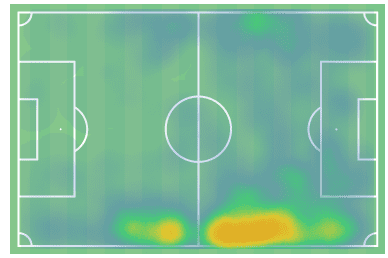
We can clearly see how he has largely stayed wide on the right this season, even in the final third, and this is a direct result of Bielsa’s tactical instructions. Doing so allows him to receive the ball in areas where he can then look to run down the line or come inside, depending on where the space is.
Before looking at examples from matches to understand Raphinha’s role in Bielsa’s tactics, it will be instructive to compare some key statistics with other Premier League wingers to see where the Brazilian has done well. All statistics have been taken from Wyscout, while we have only included players who have played at least 800 minutes in the league this season, to allow for proper comparisons to be made.
Our first scatter plot looks at dribbles/90 and progressive runs/90, as indicators of these players’ ability to beat defenders with skill and progress the ball up the pitch. The colour of each individual dot indicates their dribble success rate, with shades of red being lower and shades of green being higher success rates.
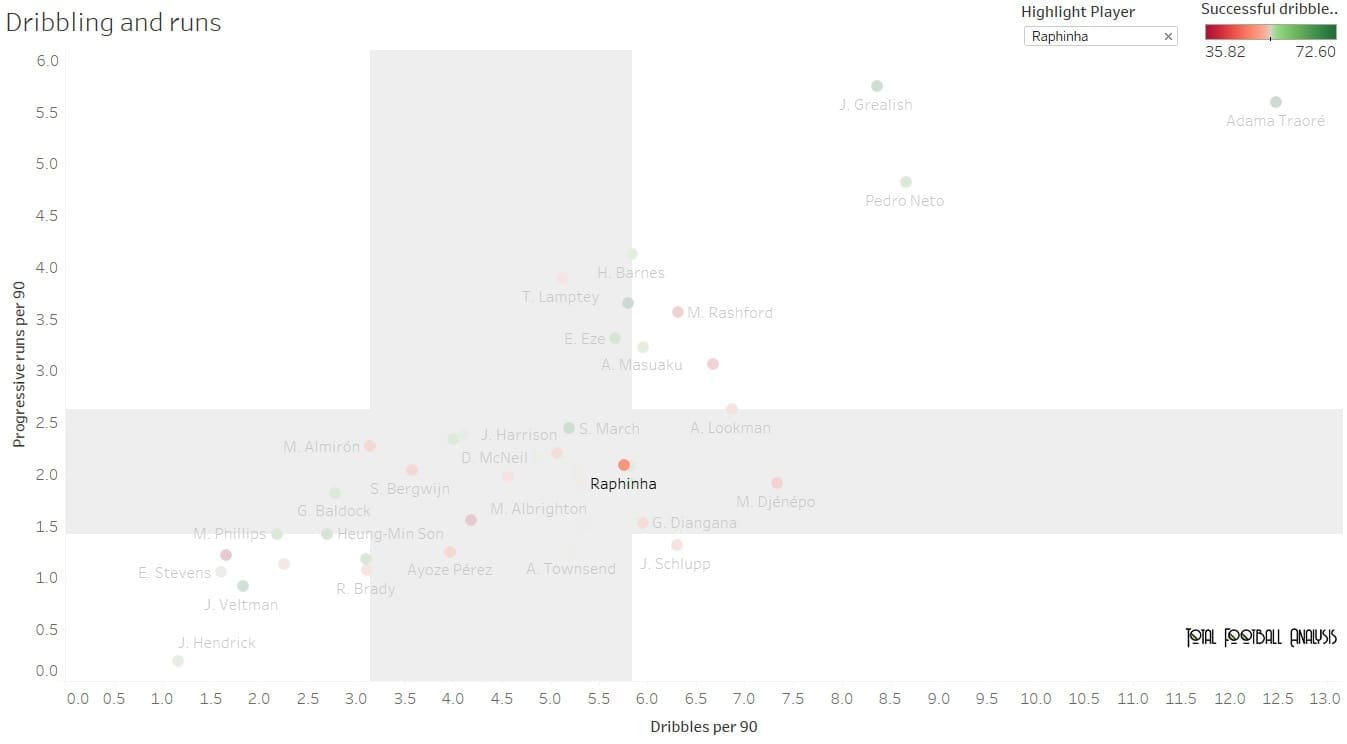
Raphinha is around the league average for both these metrics, which is not necessarily a bad thing. Under Bielsa, Leeds wingers usually stay high and wide, which means that they do not receive the ball in deeper areas where dribbles would be necessary to create space. On the contrary, the wingers are often already in space when they get on the ball, while their positioning higher up the pitch also means that there are fewer opportunities to make the sort of runs which would qualify as a progressive run.
The 24-year-old has been valuable from a creative sense for Leeds, as this next chart will show –
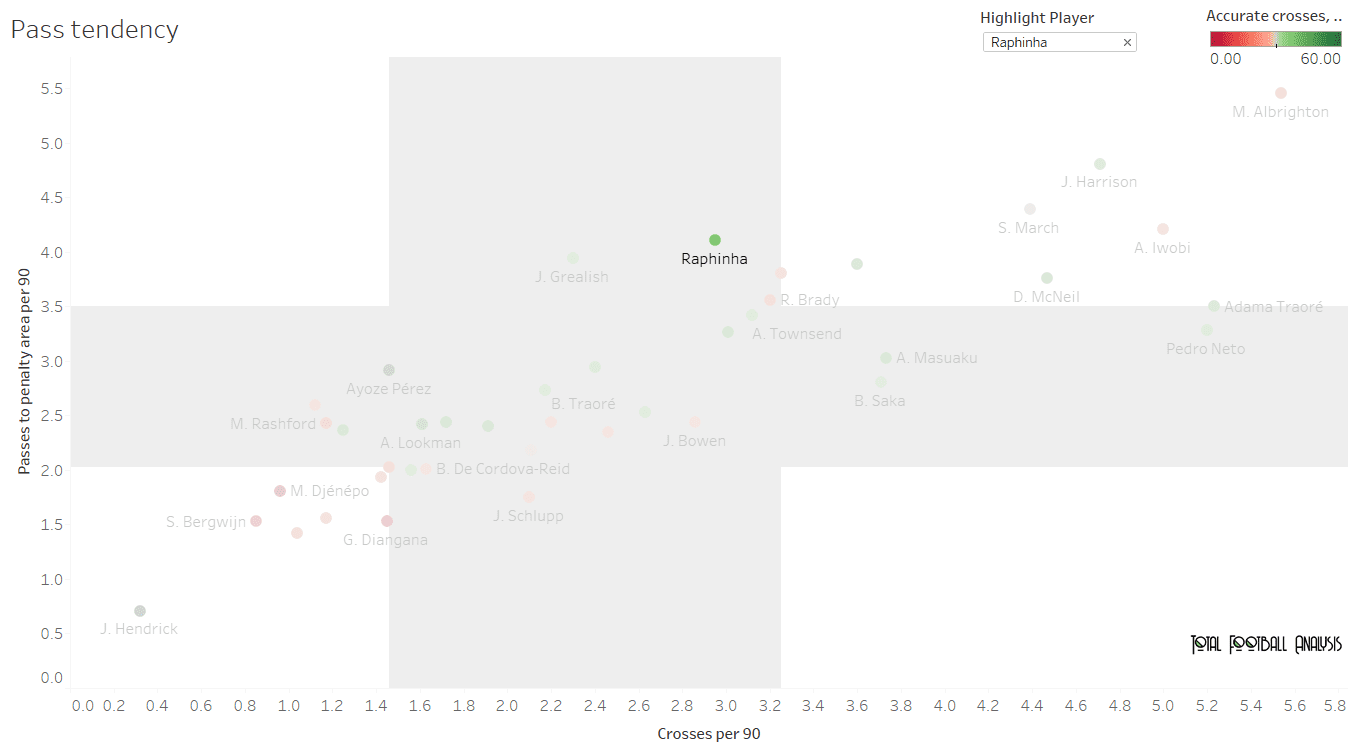
This chart considers passes to the penalty area/90 and crosses/90, while the colour of the dot indicates cross success rate. Raphinha is once again among the average for both metrics, but he has had one of the highest success rates for crosses among Premier League wingers this season (36.6%), and this chart shows that he is equally capable of crossing the ball into the box from out wide, or passing it into the area for runners and forwards to latch onto. There are very few wingers who are adept at both of these types of passes, and the fact that another Leeds player, Jack Harrison, is among the league leaders for both metrics, shows how Bielsa’s tactics emphasise on creativity from his wingers.
In fact, Raphinha has been one of the best wingers in the league if we look at goals and assists per 90 –
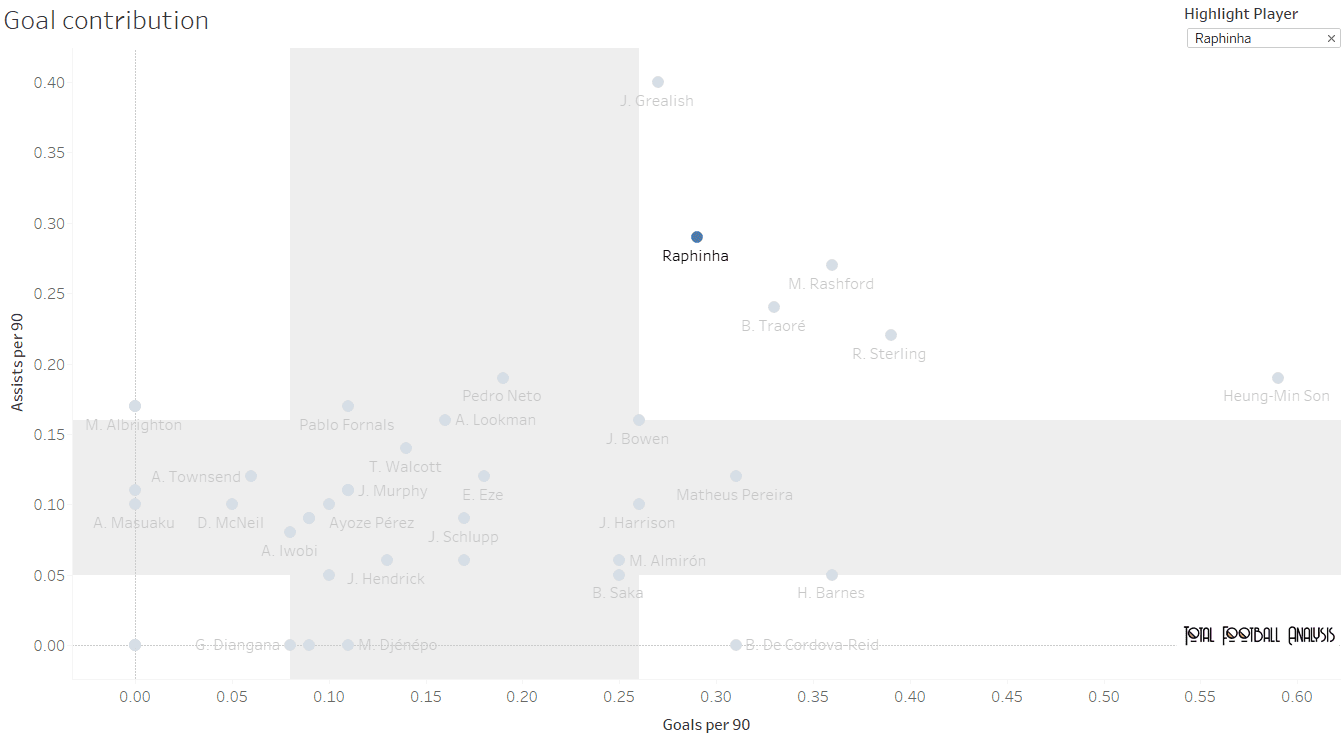
The Brazilian has been part of a select group of wingers who are above the league averages for both goals and assists per 90 minutes. In fact, Raphinha has identical figures for both in the league, with 0.29 goals and assists per 90, giving him an overall goal contribution rate of 0.58/90. This is excellent for a winger, but even more so when we look at the underlying numbers i.e. expected goals and assists.
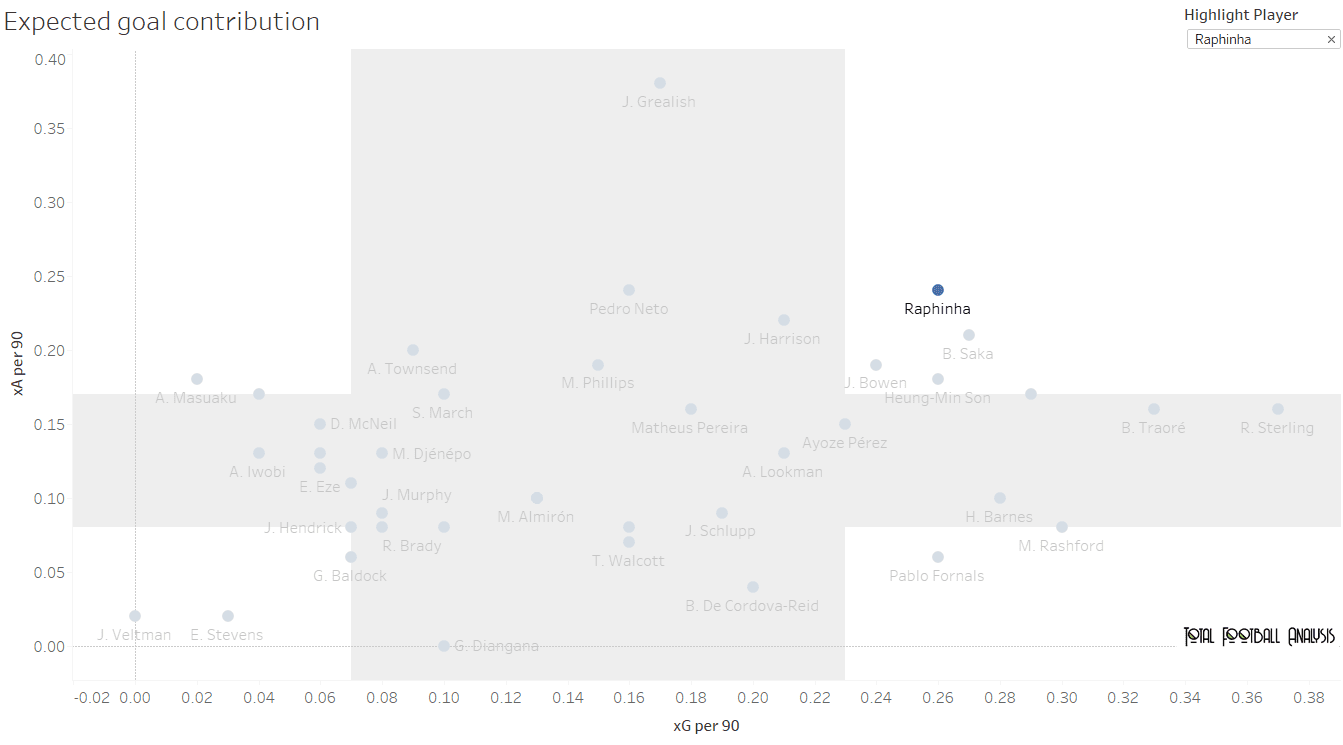
Here, we see that Raphinha is still above the league average for xG and xA per 90, which indicates that he has been getting into good goalscoring positions, and has been serving up quality chances for his teammates – both of which should mean that he is able to keep these numbers up as the season progresses. Again, his xG and xA per 90 stats are remarkably similar – 0.26 xG/90 and 0.24 xA/90, and while he has been outperforming both in terms of actual goals and assists, the outperformance is not by too much, which is an encouraging sign and signals that we should expect the Brazilian to continue scoring and assisting at a decent rate.
Thus, we have seen how Raphinha has quickly become an integral part of Leeds’ attack, supplying a goal threat while also setting up chances for his teammates. He has settled into Bielsa’s tactical system, and we will now see how that system is getting the most out of his talent and ability.
Width and wide rotations
One of the key principles of Bielsa’s tactics is for the wingers to stay wide during the first two phases of possession. This is to allow Leeds to stretch the playing area as much as possible, making it extremely difficult for the opposition to mark players without conceding space centrally. This also enables another of Bielsa’s tenets – wide rotations. You will often see Leeds building their attacks down one flank, with the full-back, winger and central midfielder all interchanging positions to create space and confuse markers. Raphinha’s role in this tactic, especially down the right flank, has been key to Leeds’ ball progression and the threat that they have posed this season.
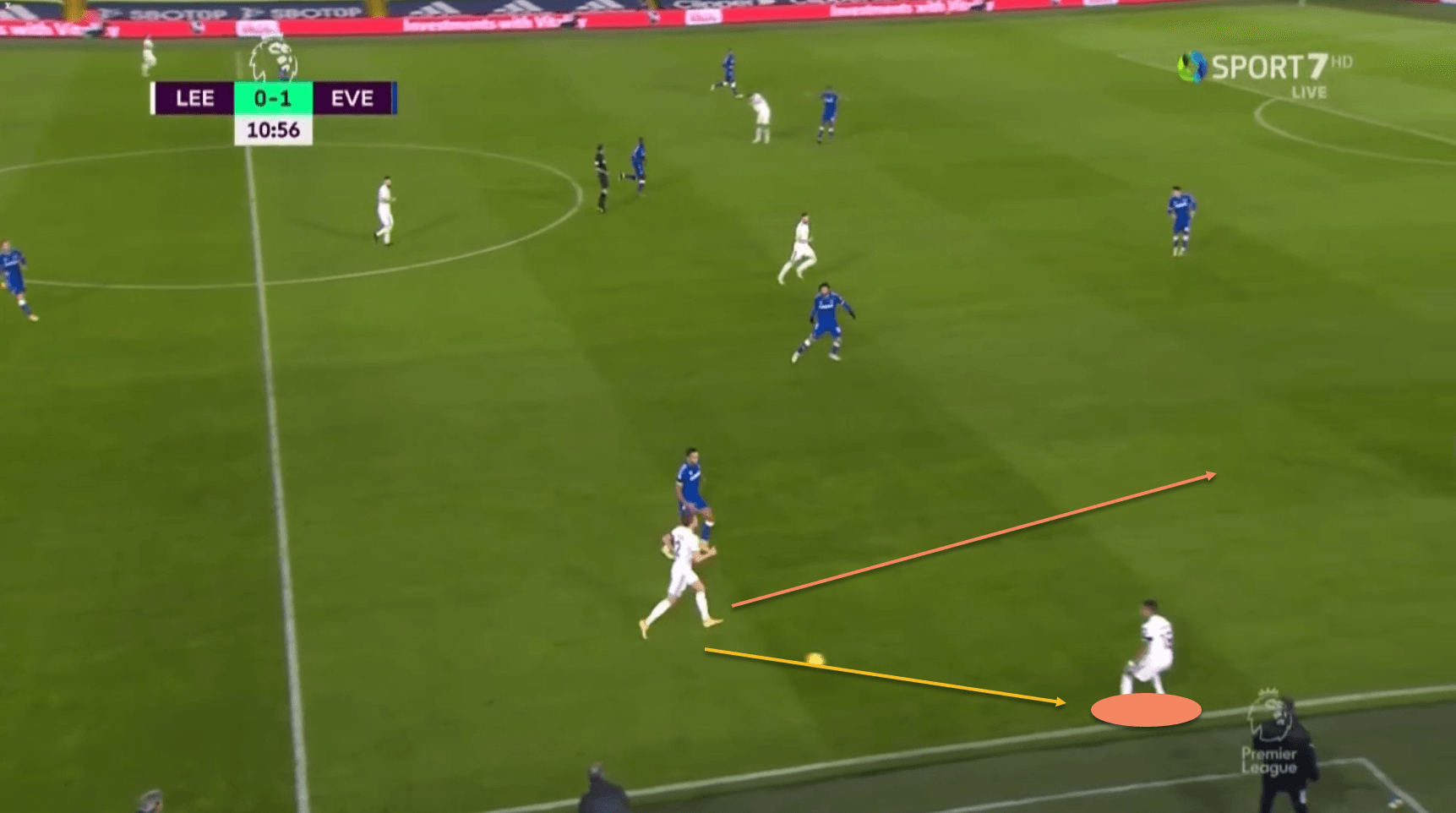
Notice Raphinha’s positioning here – the winger is hugging the touchline when he receives the ball from Luke Ayling, which opens the space up for the right-back to move into centrally.
This is a big part of Leeds’ attacking and build-up play – using width through the wingers, full-backs and even the wide central midfielders in a bid to create space in central areas. Raphinha has often been the beneficiary of this tactic, as it then allows him to cut inside on his favoured left foot in dangerous areas from the right, to cross, shoot or pass, depending on the situation.
One such example came in the game against West Brom, where Raphinha scored the side’s fifth goal after a brilliant move down the right.
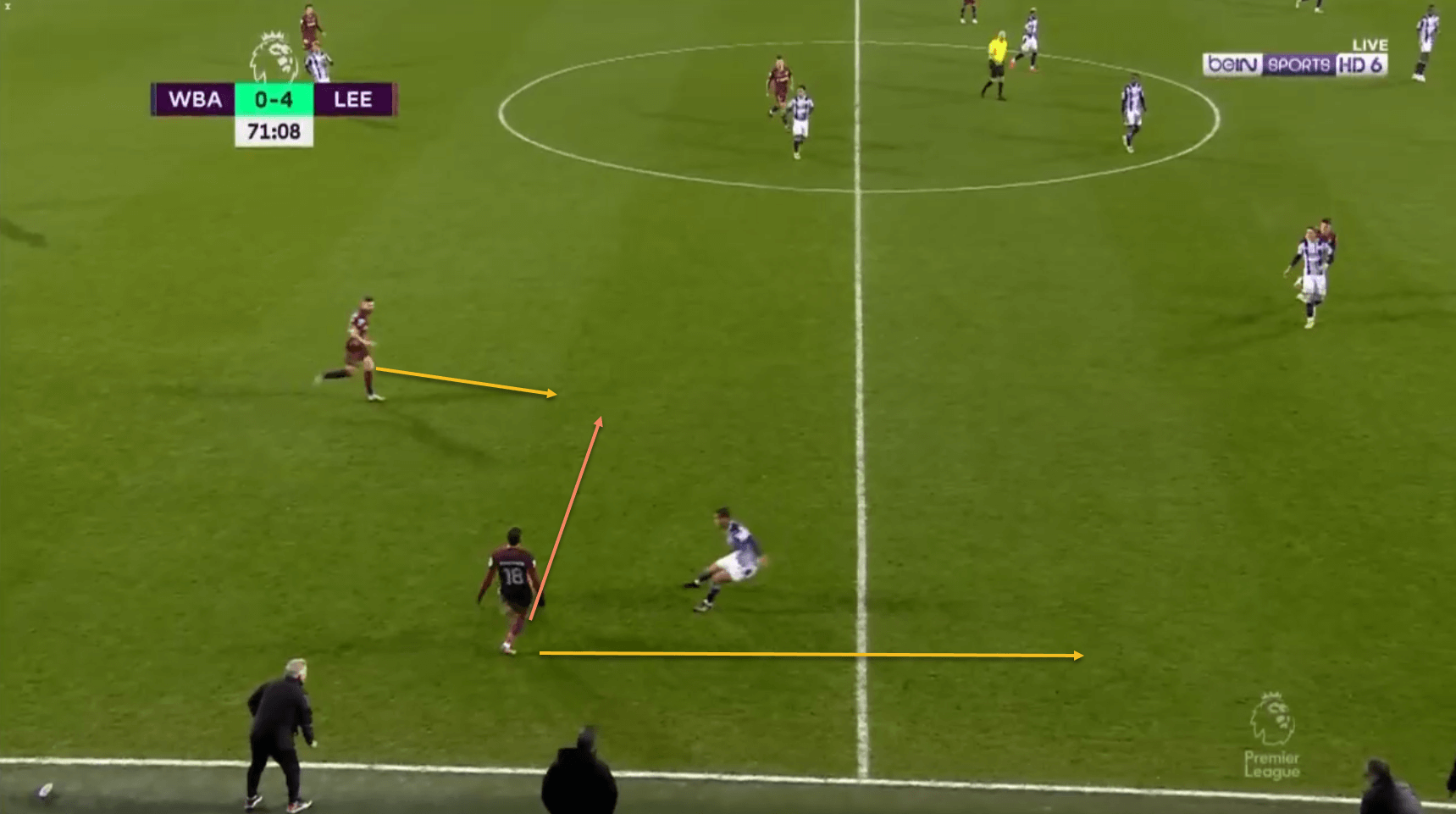
Here, the winger (#18) plays a simple square pass to Stuart Dallas, who is advancing from right-back, before moving into space himself on the right, to start the move.
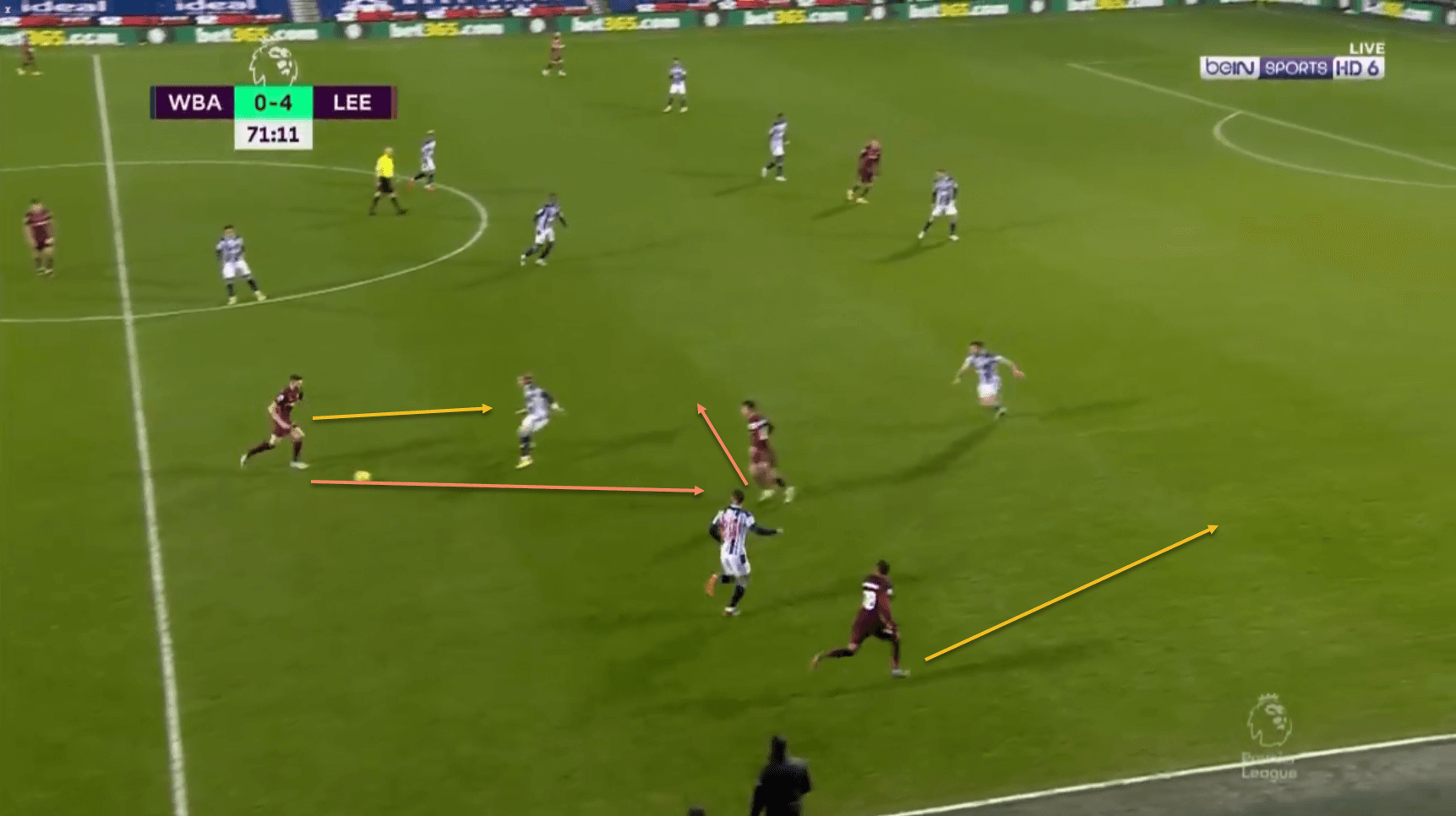
As the move develops, Leeds pick up the pace – Dallas plays a quick one-two with Jamie Shackleton, who has dropped into the space to offer support. Meanwhile, Raphinha continues his run into space, with his marker now being attracted towards Shackleton.
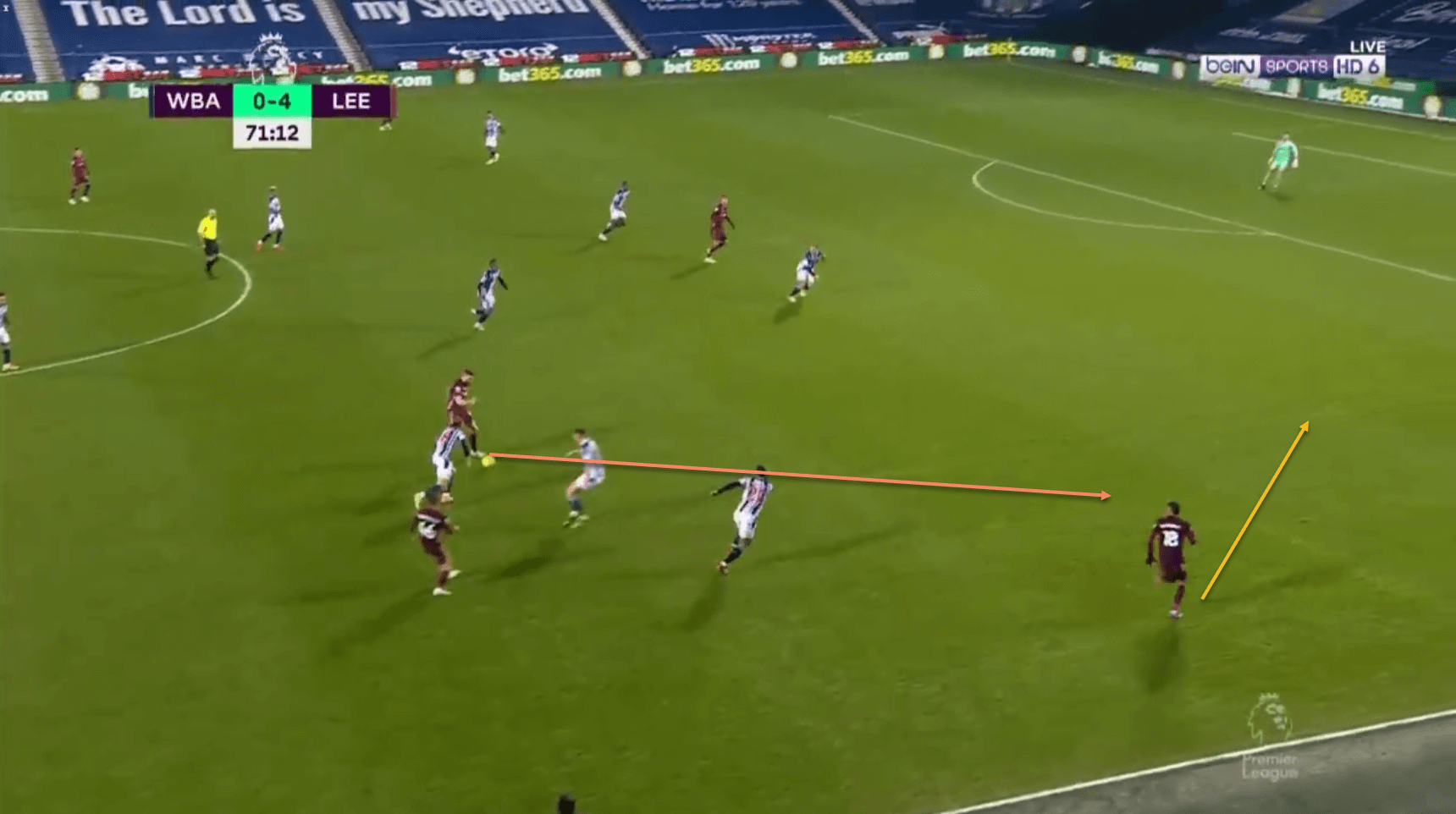
This means that when Dallas receives the ball again, Raphinha is in acres of space, and the pass from the right-back allows him to run into this area…
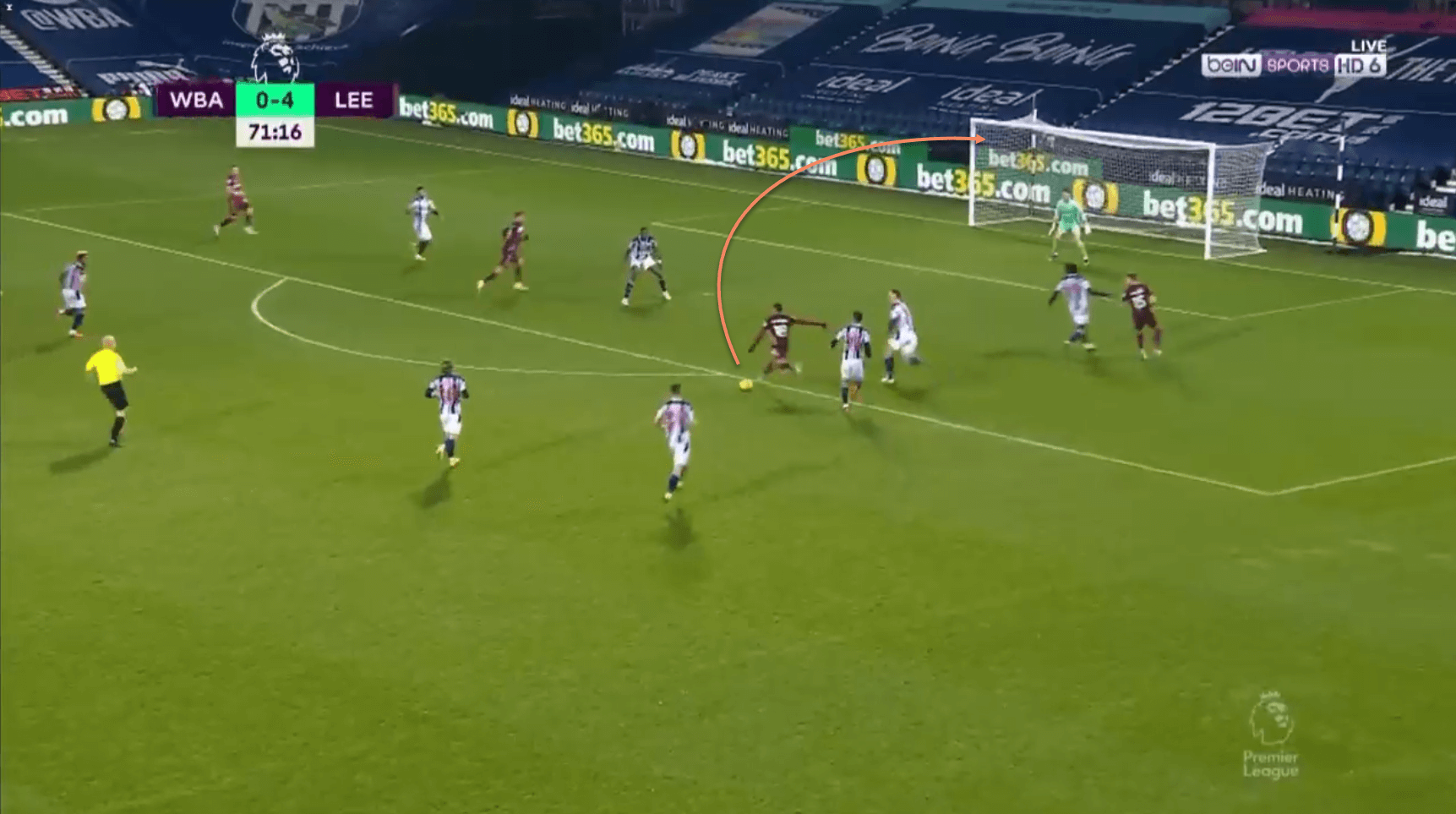
…and this move ends with the Brazilian curling the ball into the top corner from just outside the area.
It is impressive that Raphinha has picked up Bielsa’s exacting tactical demands in such a short span of time to become a key member of the team. Given that he is left-footed, one would expect him to come inside to play a lot more than he does, but Raphinha is able to stay out wide as per Bielsa’s instructions, and this, interestingly enough, is what creates the space in the final third for him to come infield.
The 24-year-old has also been used on the left on occasion, where the same principles apply.
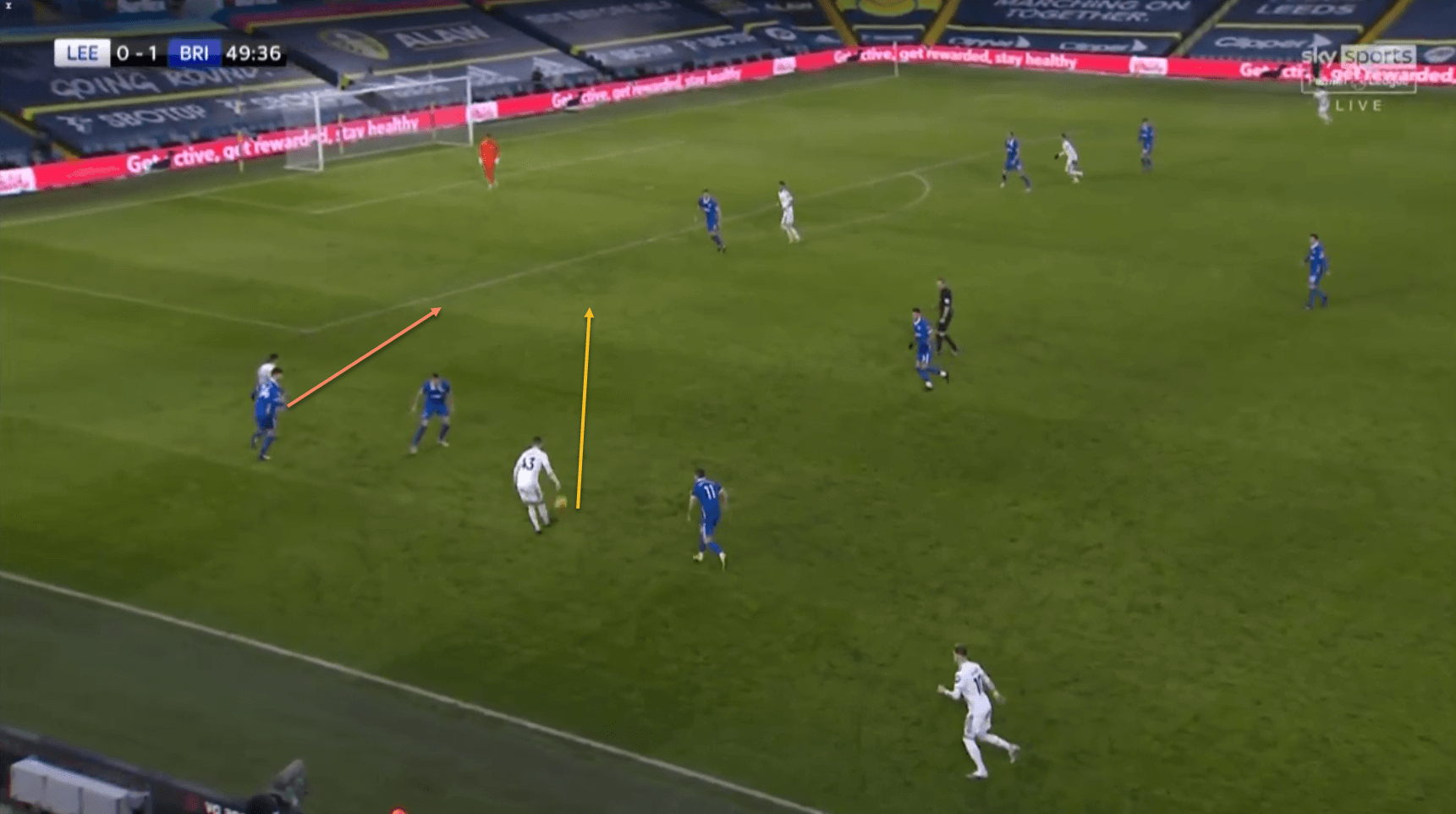
Raphinha has maintained width on the left here, before making a run into the central space that has opened up as Mateusz Klich also drifts wide and then plays the pass for him to run onto.
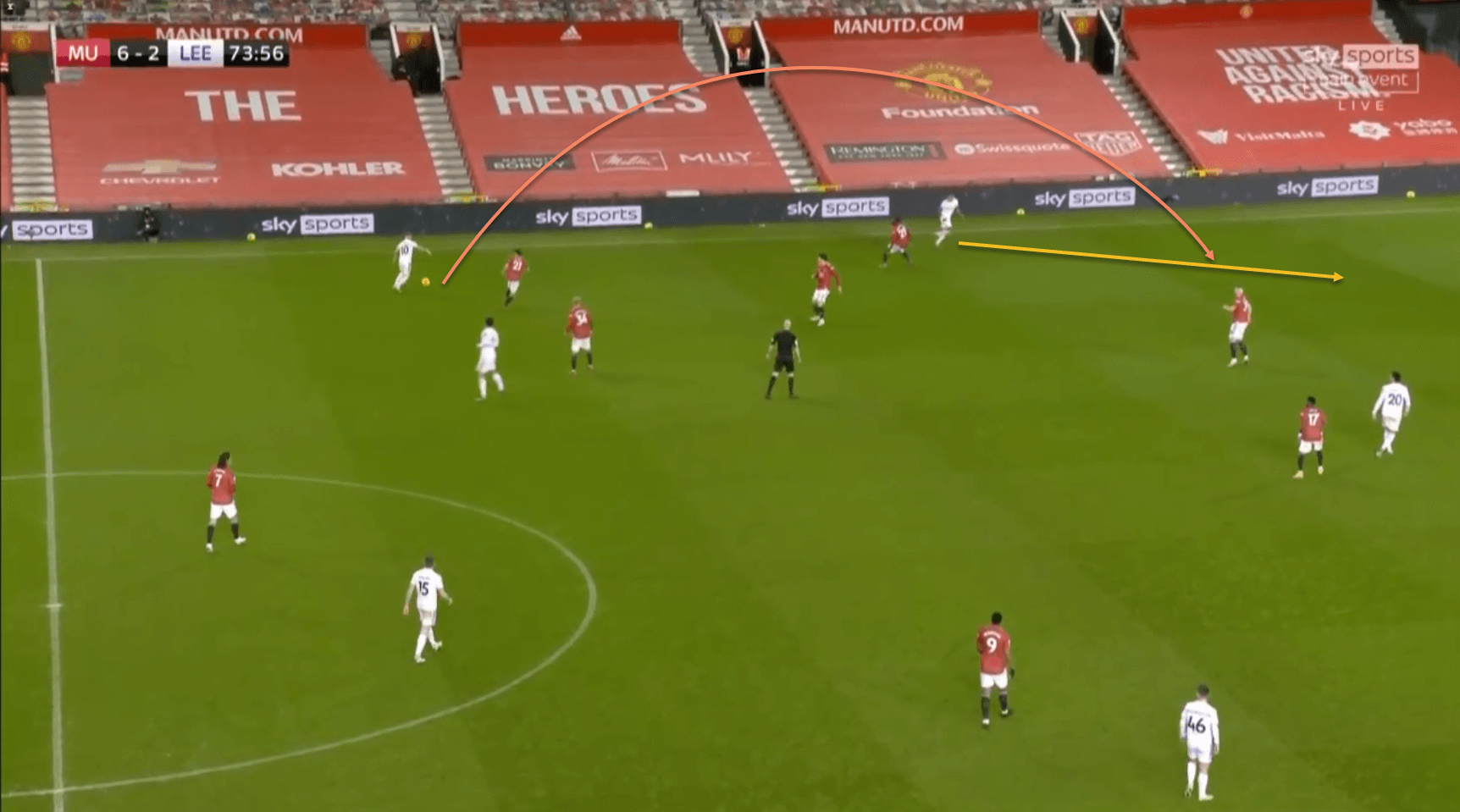
Another example, this time against Manchester United, showing how Raphinha holds width which creates the space for the ball over the top from Gianni Alioski
The Brazilian has been key to Leeds’ attacking plans this season, and it is laudable that he is following his manager’s tactical instructions in such a short span of time. This shows that the 24-year-old, in addition to being extremely gifted, is also quite intelligent, and has been able to prosper in the league as a result, both due to his own attributes, and the role that Bielsa’s tactics have played in enhancing them.
Creative ability
Raphinha has also shown the ability to be creative and set up chances for his teammates this season. He already has four assists in all competitions for Leeds this season, and has the ability to find players in the box with a variety of passes and crosses.
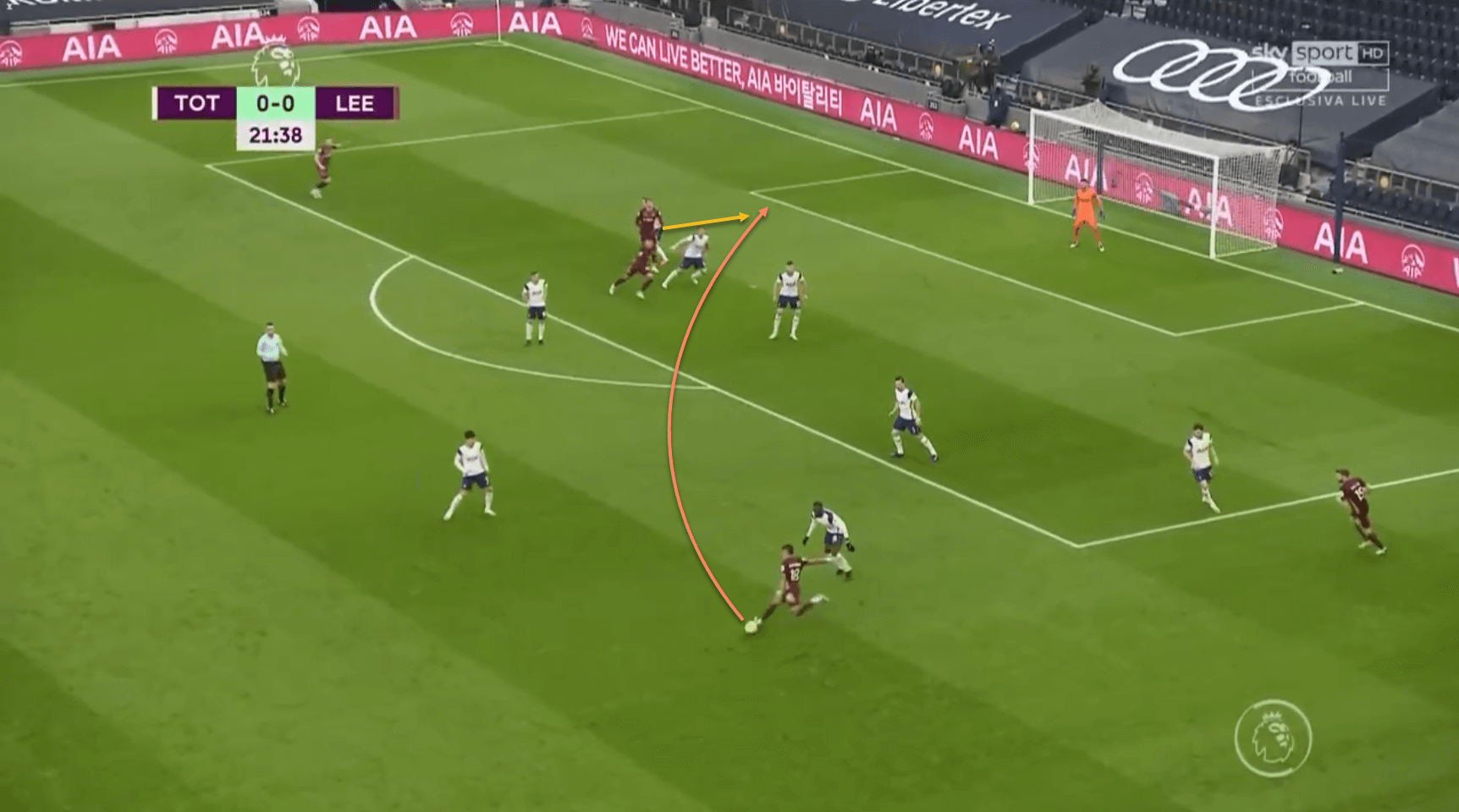
Here, the winger is able to find space in the right half-space to deliver a brilliant cross for Patrick Bamford, who is unable to get his header on target.
Raphinha is not just an excellent crosser, as seen above and also when we compared him statistically with other Premier League wingers – he is also quite capable of finding teammates with accurate passes into the box. He has already struck up a great understanding with Bamford in this regard, with Leeds’ #9 often able to run onto accurate passes fired into the box in space for him.
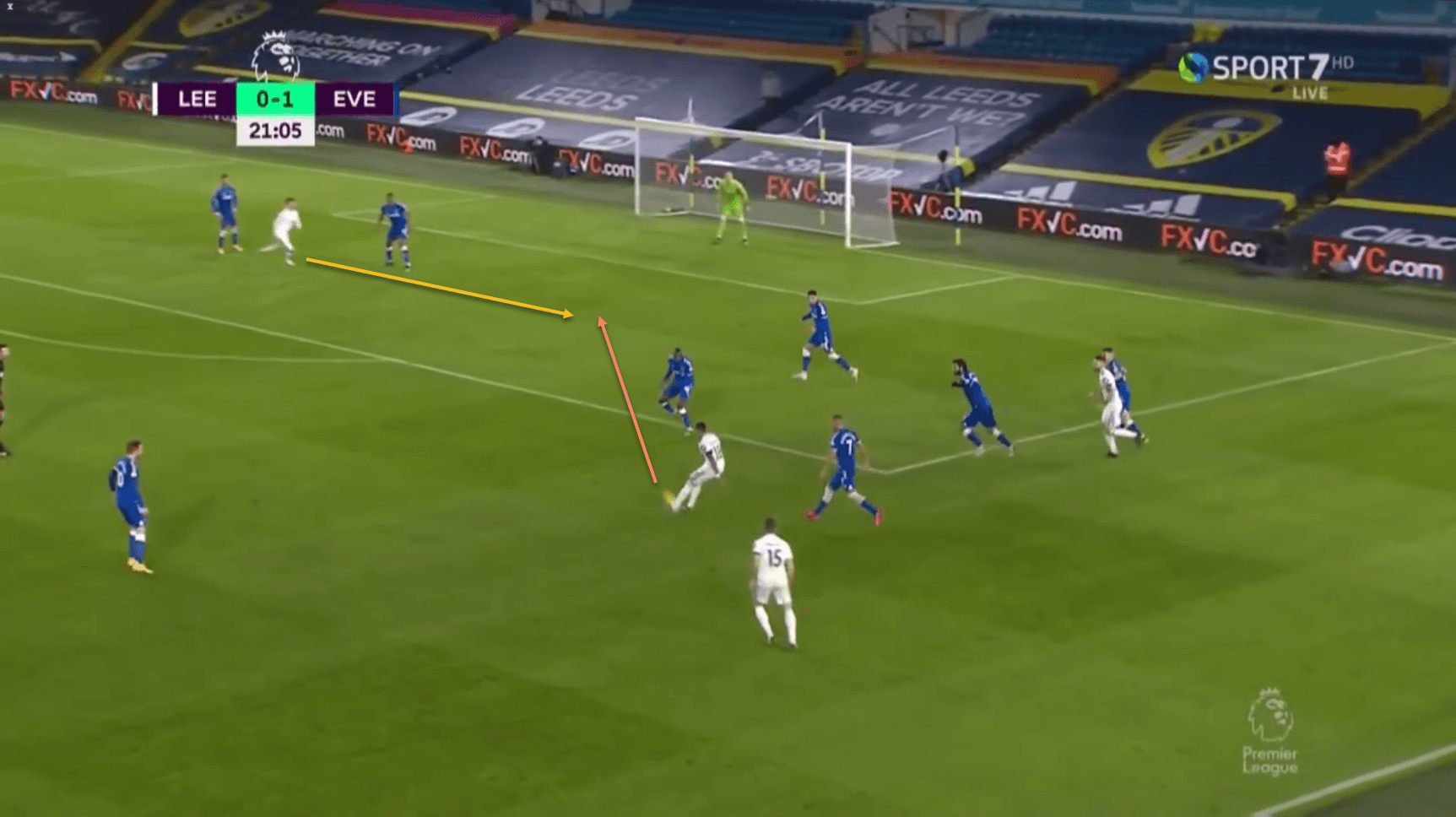
Coming off the right, in a similar position to the earlier image, Raphinha is able to pull off an accurate pass into the box which Bamford is able to receive in space.
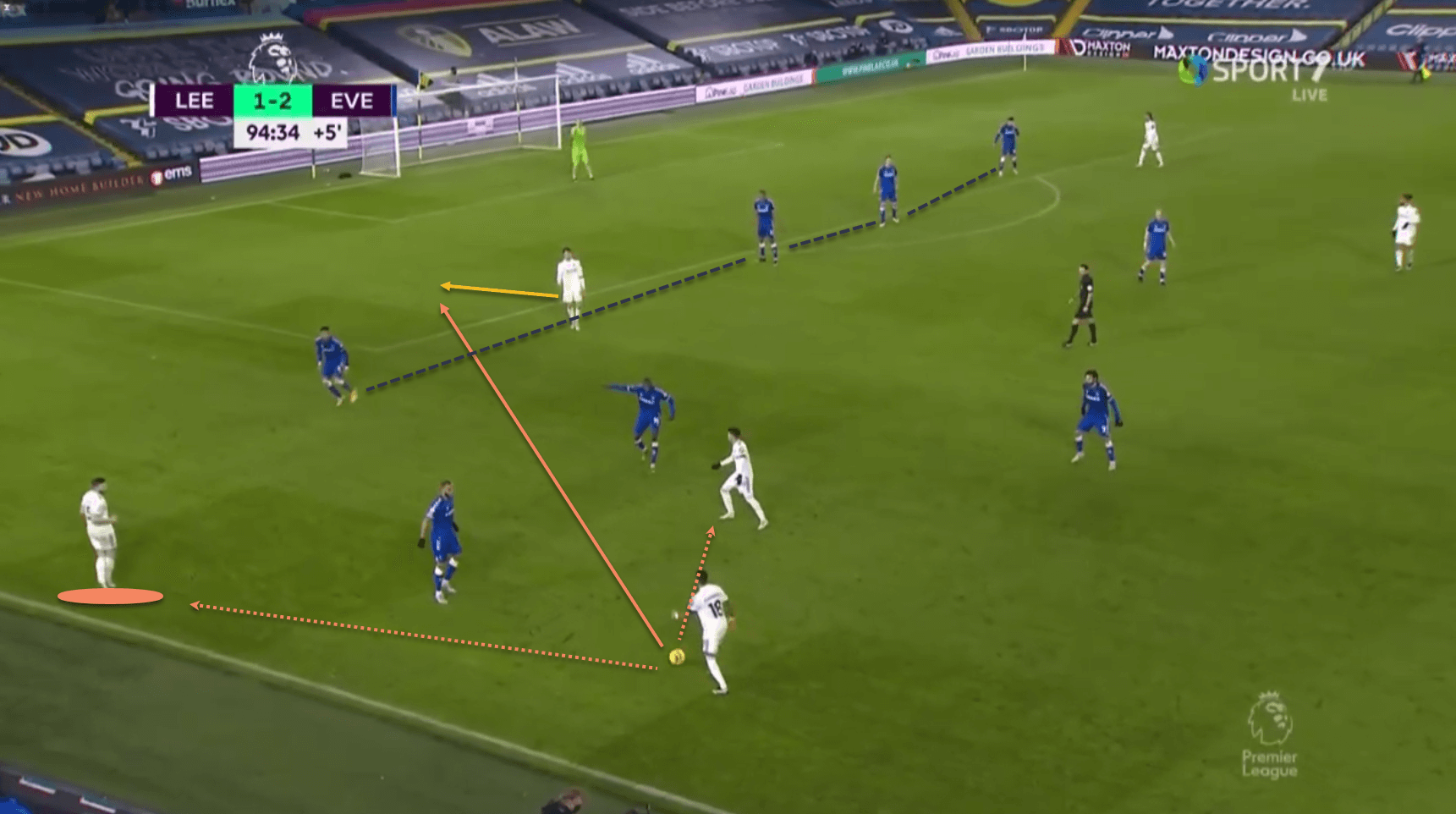
Another example, this time off the left flank. Raphinha has two simple passing options available to him – Dallas is maintaining width on the touchline ahead of him, while Pablo Hernandez is offering an option inside as well. However, the winger notices that Bamford has been able to drift into space on the edge of the box, and he therefore passes into space for the striker to receive.
Raphinha’s creative ability is not just restricted to finding teammates in dangerous areas – he himself also has a knack for drifting into space and therefore receiving the ball with time to pick his next option. Of course, this is often a consequence of his own movement as well as that of his teammates, in another example of Bielsa’s system enabling Leeds players to find space in threatening areas.
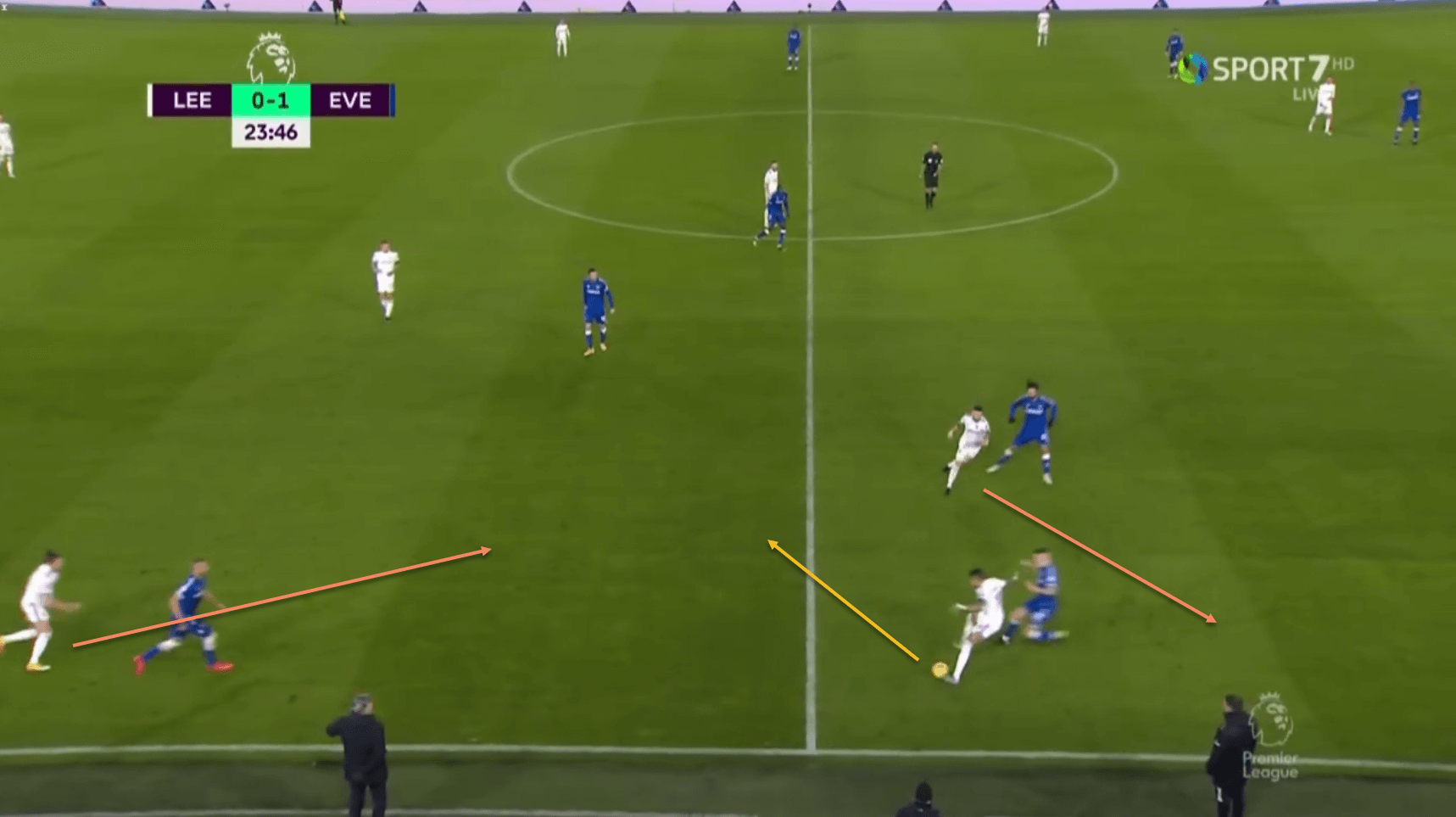
Raphinha drops near the halfway line to receive, with his back to goal, and holding off Lucas Digne to pass to Luke Ayling, who makes the run infield to receive. At the same time, Klich goes out wide, in an example of the wide rotation we mentioned earlier, to fill the space vacated by Raphinha, which drags Andre Gomes out as well.
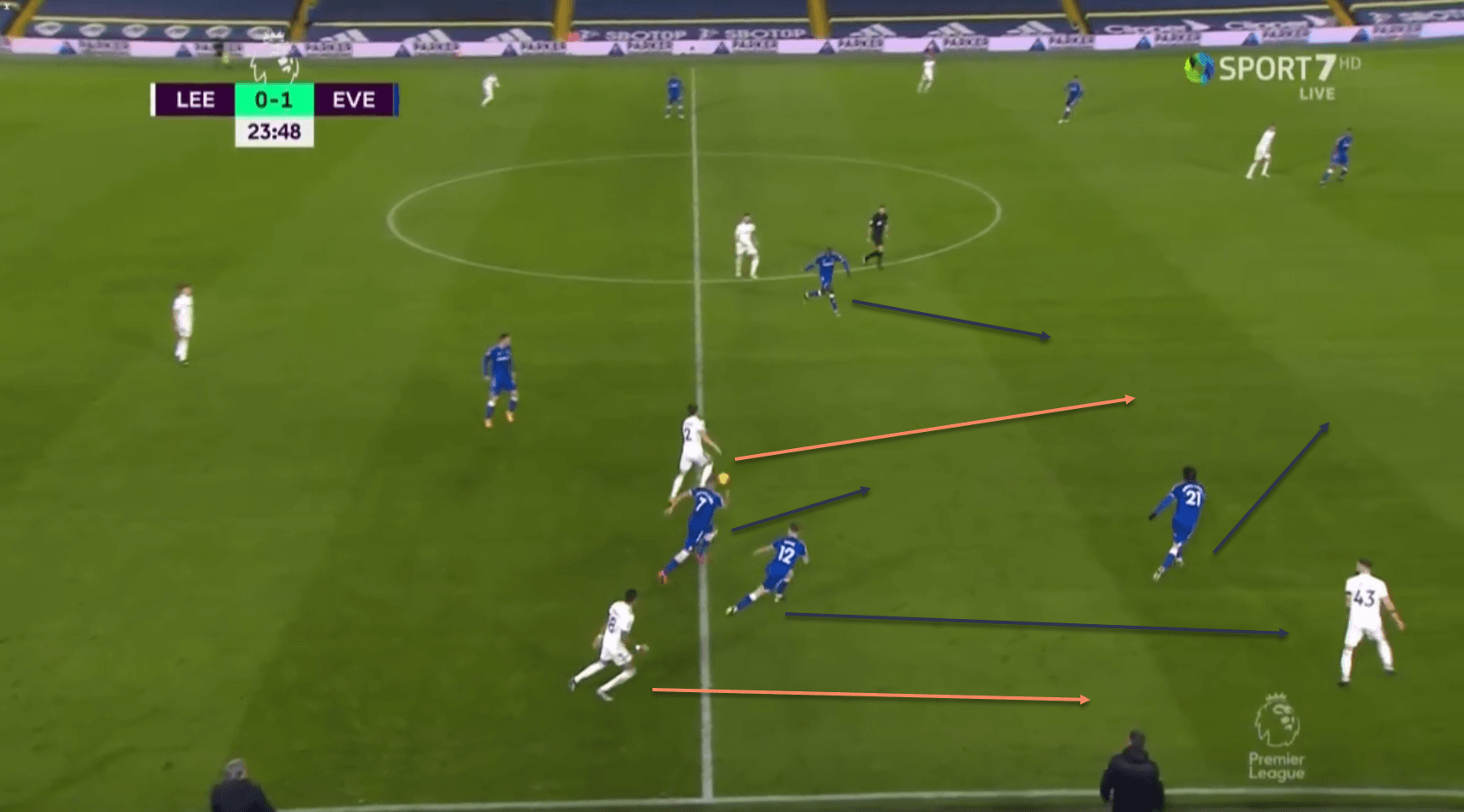
Ayling therfore has a lot of room in central areas to drive into – Richarlison tries to keep up with him, Abdoulaye Doucoure looks to come over to cover, as does Gomes. Digne drops to try and mark Klich, which means that Raphinha is free to advance into space with no Everton player on him.
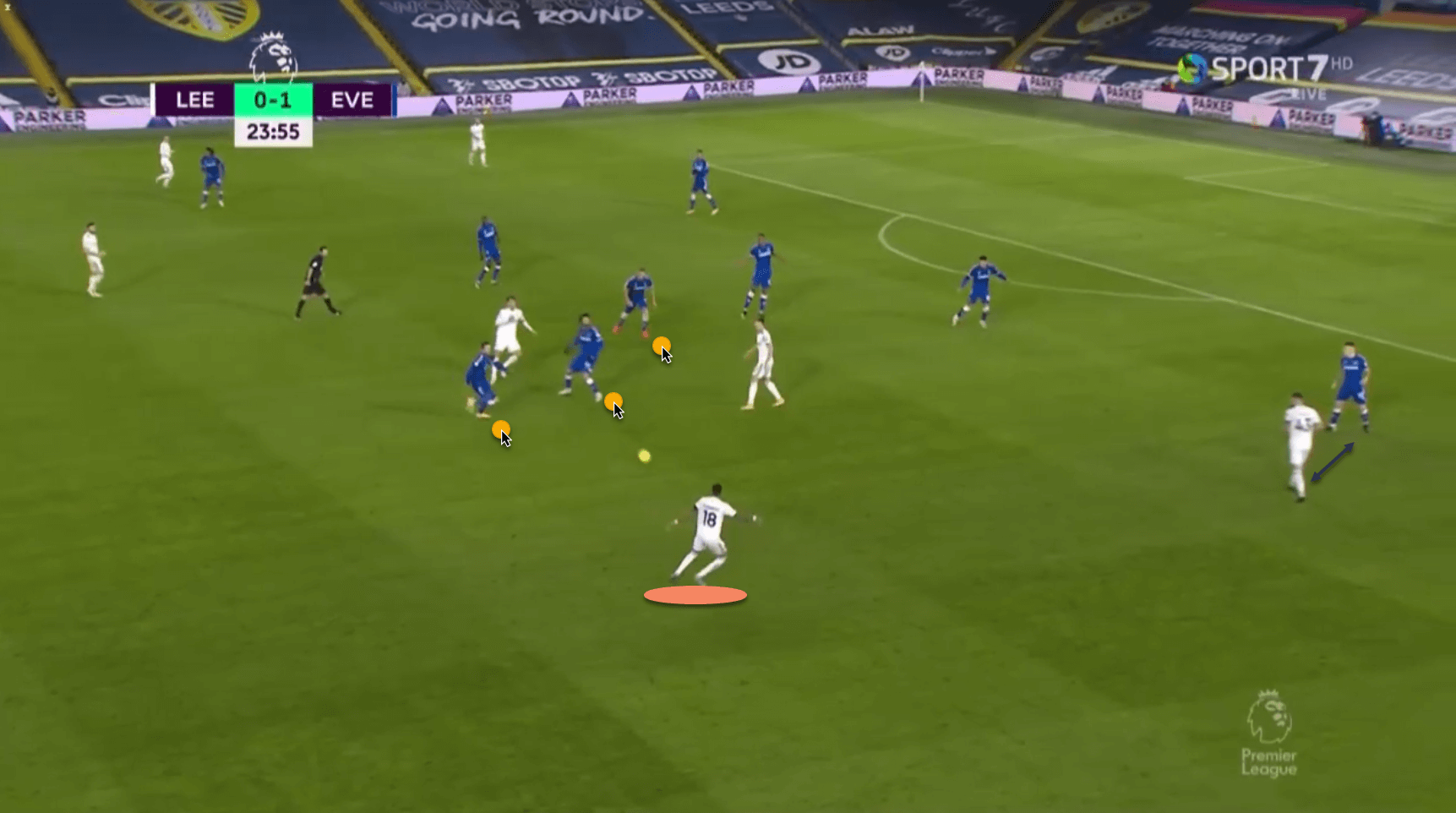
This means that he is in a lot of space to receive the ball from Bamford, with the Everton players having been drawn towards Ayling, and Digne keeping tabs on Klich.
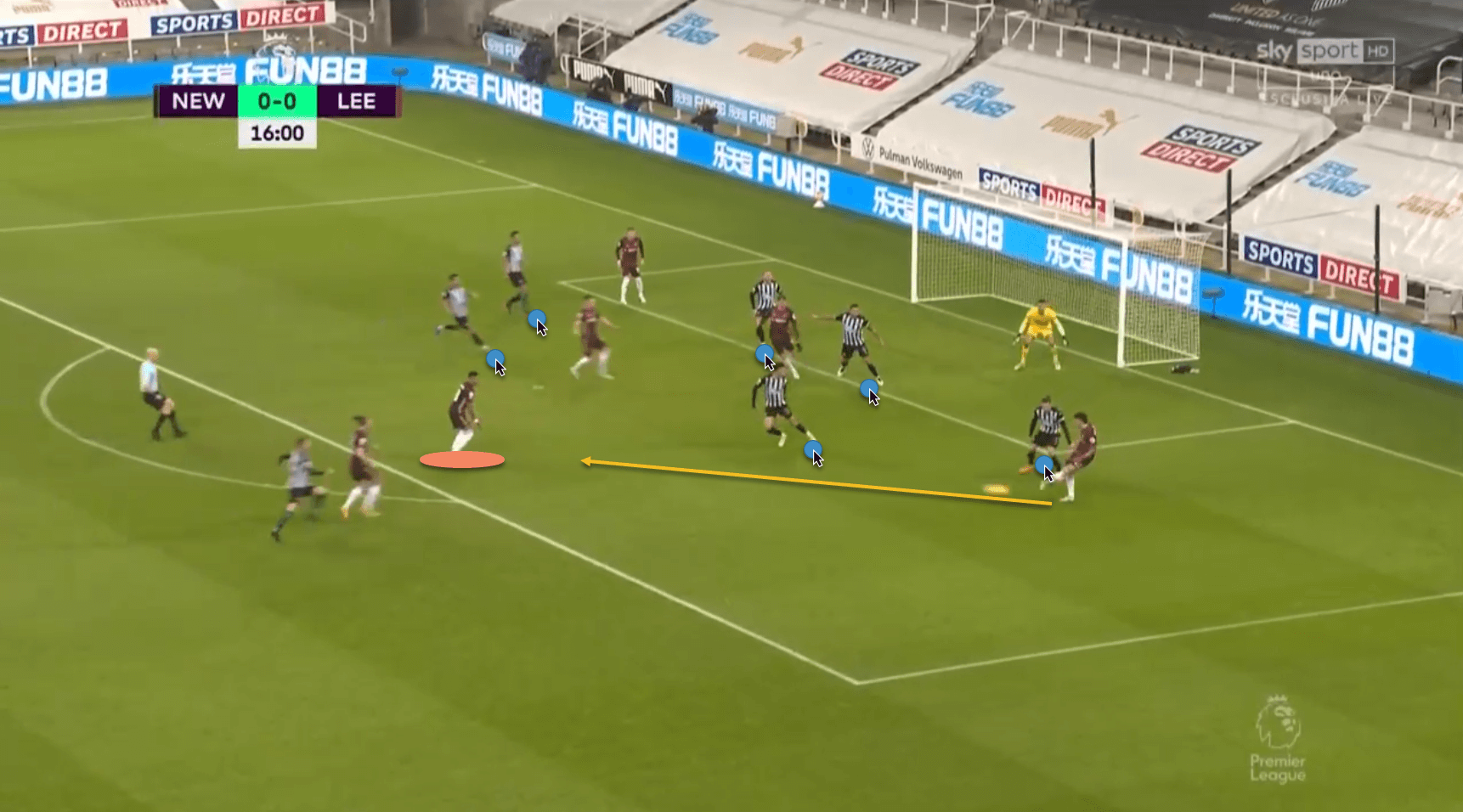
In this example against Newcastle United, Raphinha has cleverly hung back at the top of the penalty area during a Leeds counter-attack, thus finding space in a dangerous area and allowing Rodrigo to pass to him.
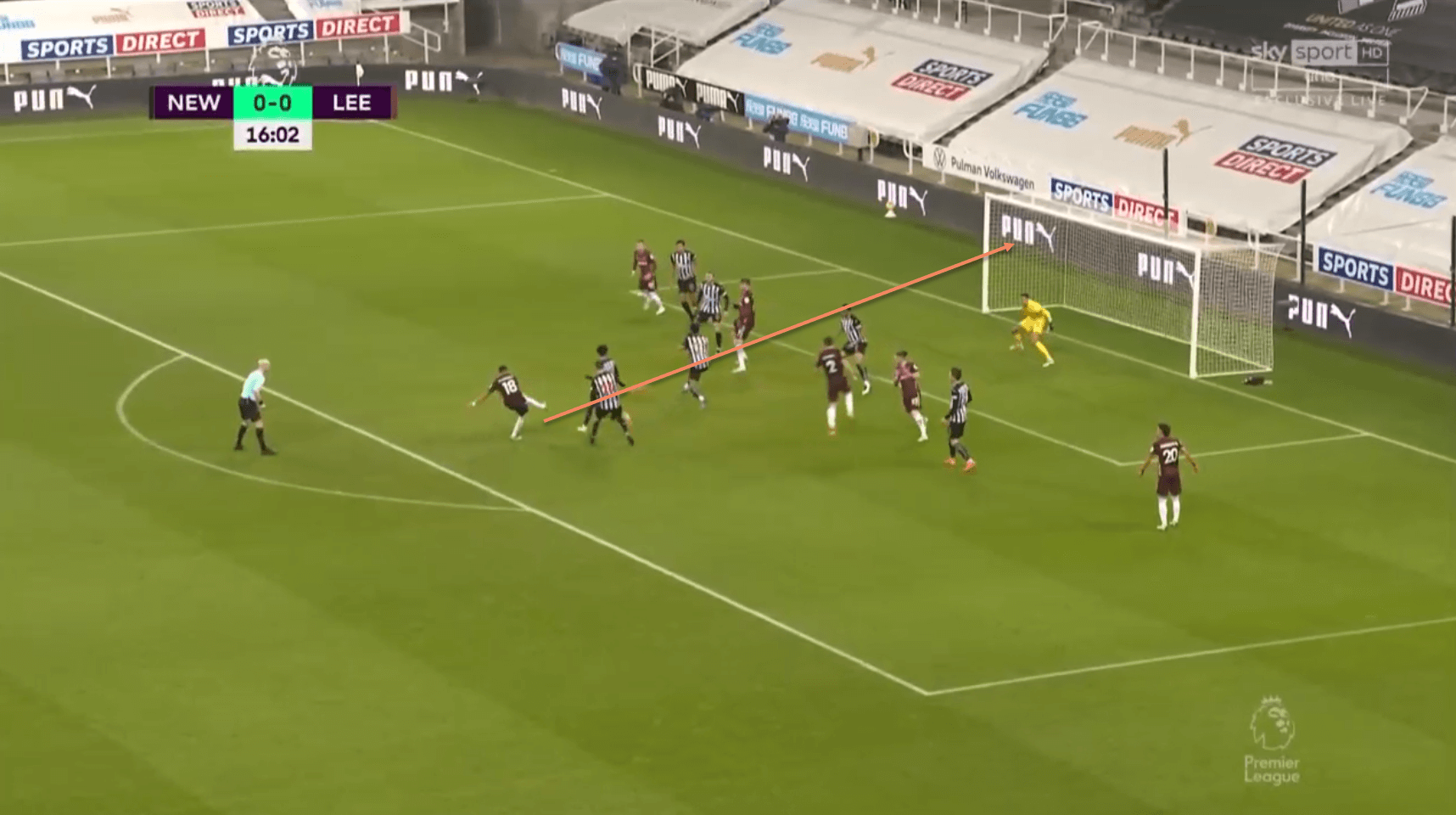
This means that he has the time to take a touch and place an accurate and powerful shot into the top corner, with the Newcastle players unable to get close enough to close him down.
Raphinha’s intelligence, allied with his role in Bielsa’s system, means that he has become a huge creative and goalscoring outlet for Leeds, and this is only set to continue as he gets more experience in the league.
Defensive work
The Leeds’ style of play under Bielsa is extremely demanding, both on a physical and mental level. Players need to make the right decision at every given time, with the failure to do so means that they are often on the receiving end of counter-attacks. Leeds have been one of the most defensively active sides in the league, topping the charts for PPDA as well as challenge intensity, and this means that every player needs to contribute when out of possession as well. Raphinha is no exception, and he has been an effective presser off the ball, with his energy being vital to Leeds’ attempts to regain possession quickly after they lose it.
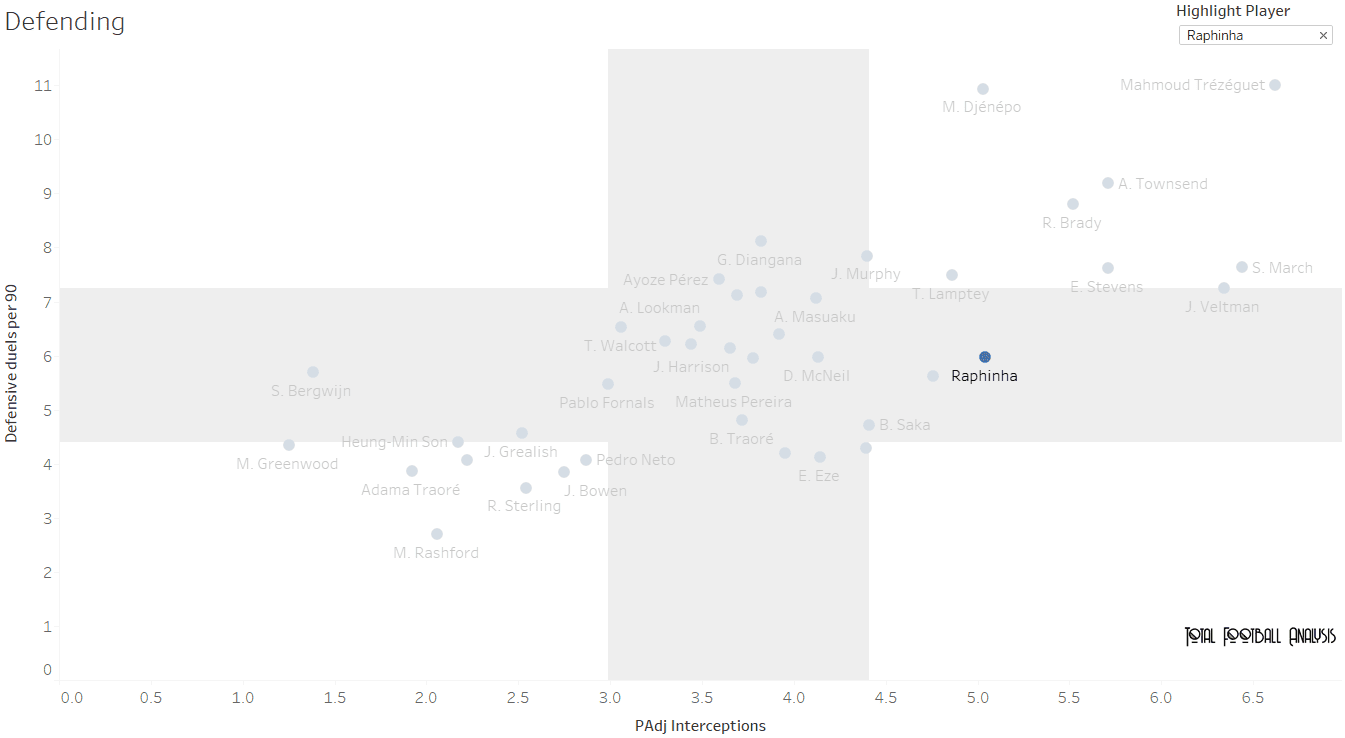
This scatter plot considers possession-adjusted (PAdj) interceptions and defensive duels per 90 for Premier League wingers this season. Raphinha has made over 5 PAdj interceptions per 90, which is well ahead of the league average, and shows his role in disrupting the opposition’s build-up when Leeds lose the ball. He is around average for defensive duels per 90, but that again shows that he is quite active when out of possession. Another interesting statistic is that Raphinha has made 3.50 recoveries per 90 in all competitions, 60% of which take place in the opposition half. This is of course a result of Leeds’ front foot approach, but the Brazilian has allowed it to flourish, playing a big part, as do the rest of Leeds’ players, in their efforts to regain possession.
Final remarks
Raphinha has been a pretty shrewd addition to Leeds’ squad this season, adding a touch of flair to the team, as well as top-level experience to a side which is still largely made up of the players who earned Leeds promotion. The 24-year-old has had an excellent introduction to the Premier League, and has already played a large part in Leeds’ performances this season. It will be extremely fascinating to see how he progresses, but already, we can see how he has slotted in perfectly into Bielsa’s tactics, and you can expect the Brazilian to continue having an impact in the final third.

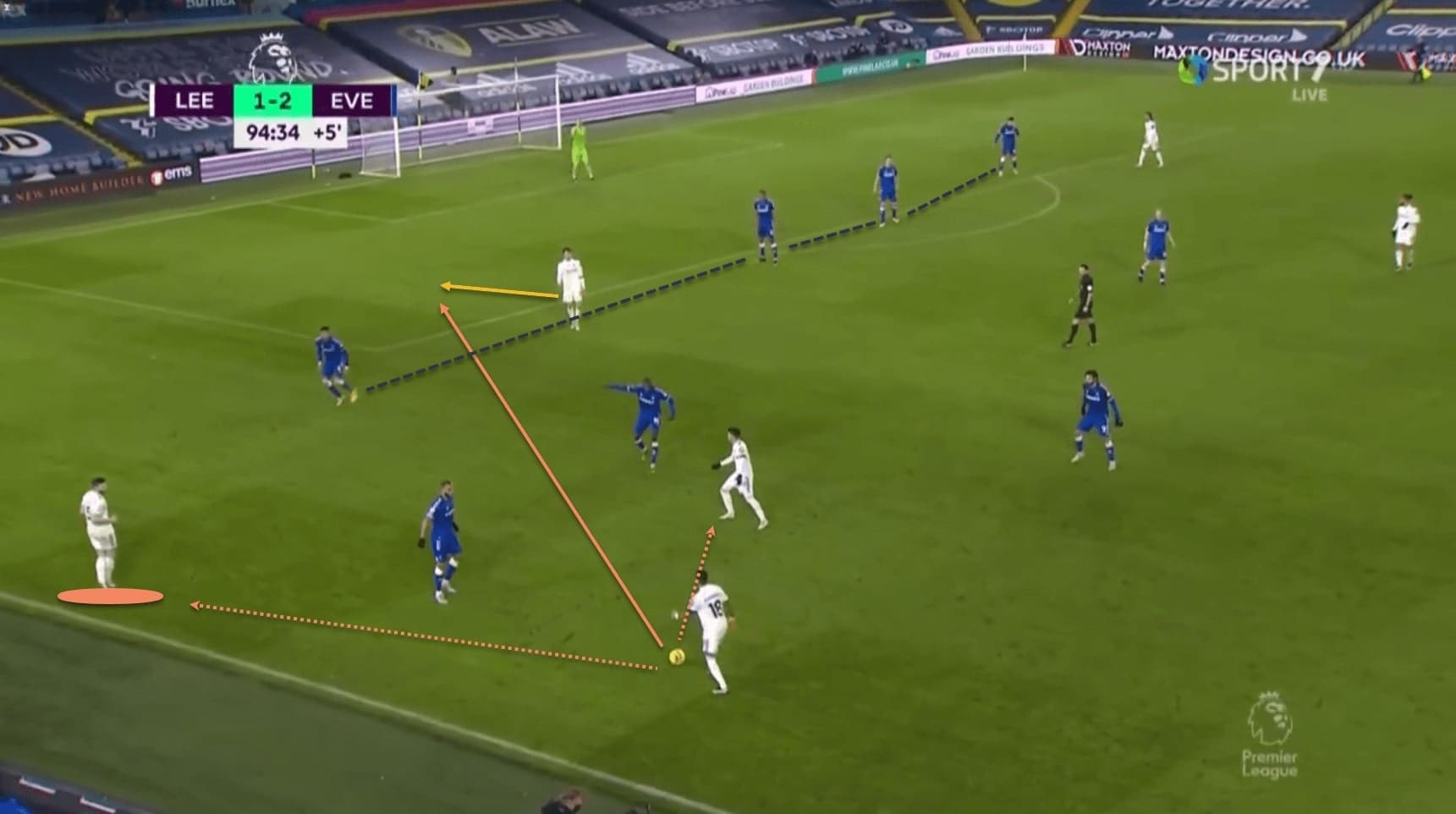



Comments